Read more about the ground cover plants and flowers you will encounter at Suncadia!
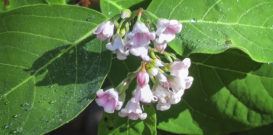
Spreading Dogbane-Apocynum androsaemifolium
Spreading Dogbane is a perennial growing to 0.6m by 1m. It is hardy to zone 4. It is in flower in July. The flowers are hermaphrodite (have both male and female organs). We rate it 2 out of 5 for usefulness.
The plant prefers light (sandy), medium (loamy) and heavy (clay) soils and requires well-drained soil. The plant prefers acid, neutral and basic (alkaline) soils and can grow in very acid soil. It can grow in full shade (deep woodland) semi-shade (light woodland) or no shade. It requires dry or moist soil.
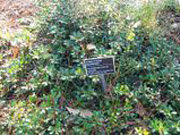
Knnikinnick-Arctostaphylos uva ursi
This ground-trailing shrub has the papery, reddish, exfoliating bark typical of woody plants in northern climates. It is frequently seen as a ground cover in sandy areas such as the New Jersey pine barrens. It is very common on Cape Cod, where it covers vast areas in open, sandy, pine-studded communities. It is a hardy shrub for landscaping rocky or sandy sites. The fruit is edible but mealy and tasteless; it is much favored by birds and other wildlife. In Greek arctos is “bear” and staphyle “grape,” whereas in Latin uva is “a bunch of grapes” and ursus is “bear.” The berries are indeed eaten by bears, as the name redundantly indicates. Kinnikinnick, an Indian word for many tobacco substitutes, is most frequently applied to this species, which also had many medicinal uses, including the alleged control of several sexually transmitted diseases. An astringent tea can be made by steeping the dried leaves in boiling water (sometimes used as a laxative). A similar species found in the Cascade Mountains and the Sierra Nevada, Pinemat Manzanita (A. nevadensis), has a tiny sharp point at the tip of the leaf. One other species, Alpine Bearberry (A. alpina), is found in New England mountaintops.
A low, matted evergreen shrub with smooth, red-brown, woody trailing stems, leathery, dark green leaves, and small, pink, bell- or lantern-shaped flowers in racemes on short branches.
Flowers: corolla 1/4″ (6 mm) long, with 5 lobes around the small opening. Bloom March-July.
Leaves: 1/4-1 1/2″ (1.3-3.8 cm) long, wedge- or spatulate-shaped, widest near blunt tips, smooth, leathery, green on both sides.
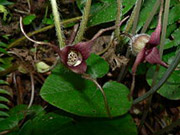
Wild Ginger-Asarum caudatum
Wild Ginger is a perennial 1′ by 3’and larger, large dark-green heart-shaped leaves 3″ across, small reddish ‘bat’ flowers. An excellent groundcover along coast in part shade or redwood garden. It needs regular water in most of Calif.. It looks un-native .The rootstock can be used as ginger. It showed a lot of damage when snow covered it for a day, but recovered nicely. Ours have gone through 10 deg. weather ok as long as the plants are in protected spots, i.e. in the open the temp was 10, under the heavy shade of a tree with 3″ of leaf litter it was 20-25.

Elk Sedge-Carex geyeri
Elk sedge is a native upland sedge that grows 6 to12 inches (15-50 cm) tall. Elk sedge grows from branched underground rhizomes and produces an extensive network of fine roots A single elk sedge plant may have a root system 4.5 feet (1.4 m) wide and 6 feet (1.8 m) deep Elk sedge rhizomes grow at a depth of 0.6 to 2 inches (1.5 to 5 cm) [ Leaves and stems grow in bunch form or are more loosely clustered. Leaves grow 2 or 3 to a culm and are 0.04 – 0.14 inch (1-3.5 mm) wide, flat or nearly so, leathery, and evergreen].
Elk sedge is easily recognized by its few-flowered, solitary spikes. The spike has a slender staminate part bearing male flowers above the 1-3 pistillate (female) flowers, which are distinctly separate and bear scales with a short awn at the tip. Each spike bears 1-3 perigynia in which large seeds are tightly encased]
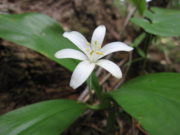
Beadily Queens Cups -Clintonia uniflora
This very desirable rhizomatous lily is not impossible to grow, but difficult. One or two pure white flowers rise above the wide basal leaves in early summer. Each is replaced by a single Prussian-blue berry. Adapted to cool, damp, acid, mossy, well-aerated conifer duff and dappled shade. Native from SW British Columbia to California. Our plants are from seeds collected in south-central BC near Kelowna and Clearwater. The ones we ship are at least 2 years old and 2-3 years from flowering. Plant them immediately in a permanent spot. They resent disturbance, but in the right circumstances will form extensive mats. Height 10-20 cm (4-8″).
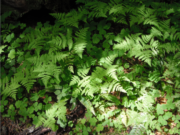
Oak Fern- Gymnocarpium dryopteris
Oak fern is a delicate perennial from slender, spreading, blackish rhizomes with brown, fibrous scales; stalks usually single, but often in masses, erect, 8 – 35 cm tall. The leafs are broadly triangular in outline, 5 – 18 cm long, 5 – 25 cm wide, 2 – 3 times pinnate, hairless; 3 major, approximately equal divisions, each with 4 – 7 pairs of lobes or leaflets, smallest segments round-toothed; stalks very slender, shiny, straw-colored, sparsely scaly at base, usually longer than blades. Oak Fern has small, circular dots on veins, near leaflet edges, no indusium.
The groundcover grows well in moist forests, thickets, and rocky slopes; scattered across Northwestern Ontario’s boreal forest north to Great Slave Lake and approximately 65 degrees N in Yukon and Alaska; circumpolar.
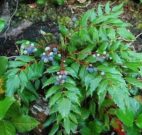
Oregon Grape, Cascade-Mahonia nervosa
Oregon Grape Cascade is a low, evergreen shrub. Leaves: 10″ (25 cm) long, pinnately compound, with 9-19 lanceolate, spiny-edged, 2″ (5 cm) leaflets; evergreen. A low, evergreen shrub. Leaves: 10″ (25 cm) long, pinnately compound, with 9-19 lanceolate, spiny-edged, 2″ (5 cm) leaflets; evergreen. Flowers: 1/2″ (1.5 cm), yellow, with petal-like parts in concentric whorls; in 8″ (20 cm) clusters; bloom March- …lowers: 1/2″ (1.5 cm), yellow, with petal-like parts in concentric whorls; in 8″ (20 cm) clusters; bloom March.
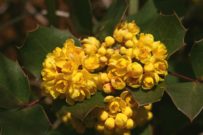
Creeping Oregon Grape-Mahonia repens
Creeping Oregon grape is a much smaller, more compact member of a family valued by landscapers for their bright yellow flowers, evergreen leaves, and bluish berries. It is similar to shining Oregon grape, but is lower and more spreading, with trailing stems (repens means crawling or trailing). It is stoloniferous with stems reaching from 7.5-15 cm in height. The compound pinnate leaves have 5-7 oval leaves, generally less than twice as long as broad. The leaflet margins are edged with 15-43 spinulose teeth, and the upper surface may be glossy or dull. The compact racemes of bright yellow flowers are found at the apex of the stems.
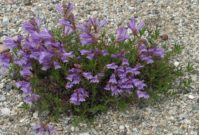
Shrubby Penstemon- Penstemon fruticosus
Shrubby penstemon is a woody, mat-forming penstemon with numerous flowering and sterile stems atop dense mats of leaves. The flowering stems may reach a height of 40 cm and are freely branched. The leaves are evergreen, leathery, and shiny green. The leaves are both basal and cauline (stem), with the latter being smaller. In a variety fruticosus, the leaves are up to 6 cm long with entire or finely toothed margins.
The inflorescence is a few-flowered raceme. The glandular sepals are pointed at the tip. The corolla is blue-lavender to purple, and up to 5 cm in length. The palate is bearded and white or yellowish in color. The flowers are tubular with two spreading lips. The lower lip is longer than the upper. The calyx is glandular with entire-margined, leafy sepals from 7-15 mm long. The anther sacs are densely white and woolly. The staminode is yellow-bearded at the narrow tip and about one-half the length of the filaments.

Spreading Phlox-Phlox diffusa
Spreading phlox is a beautiful, primarily mat-forming perennial. It may occasionally be found with upright growth, but not exceeding 10 cm in height. Its leaves are green, and not sticky or hairy. They tend to be much softer to the touch than those of Hood’s phlox. Leaf shape is acicular or needle-like, with a length of 5 to 20 mm, and a width of 1 to 2 mm.
The flowers are solitary and nearly sessile at the ends of the stems. The calyx is somewhat hairy, with flat membranes between the calyx ridges. The flowers are tubular, with the 5 petal lobes angled perpendicularly away from the tube. The tube is about 9-17 mm long, with the lobes being 5 to 9 mm long. The flower color is white, pink, or light blue. The style is 2-4 mm long. One anther is found near the opening of the tube, two below its base, and an additional two just above the middle of the tube (at about the same height as the tip of the style and stigmas).
Spreading phlox is suitable for the front of flower borders or the rock garden. One should provide good drainage, perhaps a raised bed, and limit the intrusion of taller species that might outcompete it. Cushions may extend to about 50-80 cm wide. It does survive the moist climate west of the Cascades fairly well.
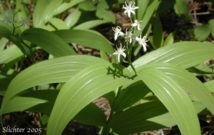
Starry Solomon-Plume-Smilacina stellata
Star-flowered false Solomon seal is an attractive perennial wildflower suitable for the woodland garden. It spreads extensively via rhizomes which send up flowering stems from 20-60 cm high. The erect stems range from straight to zigzag. The leaves lack stems and extend outwards perpendicular from the stem or ascend, sometimes close to the stem. The blades are lanceolate to oblong-lanceolate or elliptic in shape, tapering gradually to a point. The venation is parallel and the upper surface generally lacks hairs, the lower surface may be hairless or may be fairly heavily pubescent. The blades measure 5-17 cm long and 1.5-5 cm wide.
The inflorescence is a few-flowered raceme of from 5-10 flowers. The stem of the raceme often zigzags and the raceme measures from 3-6 cm long. The flowers are white with 6 tepals which are narrowly oblong or lanceolate in shape and measure from 4-7 mm long and 1-2 mm wide. The stamens range from 8-14 mm long. The fruit is a greenish-yellow berry that is globose in shape and measures from 7-10 mm wide. The berry may have reddish stripes as illustrated by the photo below.
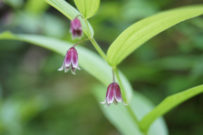
Rosy Twistedstalk-Streptopus roseus
The stems of the rosy twisted stalk are usually single and unbranched, rising 15-30 cm high from underground rhizomes. The leaves alternate along the stems and are oval to elliptical in shape with parallel venation. They measure from 5-9 cm long and 2-4.5 cm wide and do not clasp the stem (like those of clasping-leaf twisted stalk do) at their base.
The flowers are suspended below the stems on straight, thin pedicels from 9-20 mm long. The flowers are rose or reddish in color, tipped with white or greenish-yellow. The tepals are narrowly oblong-lanceolate in shape, spreading only slightly at the tips. The 6 stamens are several millimeters shorter than the tepals. The fruit is a bulbous, oblong red berry 5-6 mm long.